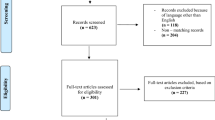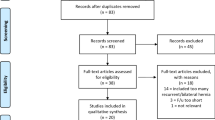Abstract
Background
Obturator hernias are rare and associated with high mortality. However, the optimal surgical approach remains unknown. We aimed to investigate the available evidence and examine the surgical details regarding obturator hernia defect closure as well as the recurrence rates of the different approaches.
Methods
We reported this scoping review according to the PRISMA-ScR (Preferred Reporting Items for Systematic reviews and Meta-Analysis Extension for Scoping Reviews) and registered the protocol online. A comprehensive literature search in five different databases was conducted. The population was patients undergoing surgery for obturator hernia. Articles were included for data charting if the management of the hernia defect was reported. Data regarding surgical details, and hernia recurrence were extracted.
Results
A total of 1299 patients from 313 articles were included. In total, 937 patients underwent open obturator hernia repair, in which 992 hernias were repaired (including some bilateral obturator hernias). A total of 295 patients underwent laparoscopic repair for 341 obturator hernias, and for the remaining 67 patients, type of surgery was not reported. For open surgery, suture repair was the most common method of repair (n = 508, 51%) with a recurrence rate of 10%. For laparoscopic surgery, the most common repair of the defect was mesh repair (n = 299, 88%) with no reported recurrences.
Conclusion
Open surgery with primary suture repair is the most common method of repair for obturator hernia but is associated with a recurrence rate of 10%. Laparoscopic mesh repair is becoming more common and have seemingly very low recurrence rates and may be a better method of repair.

Similar content being viewed by others
Data availability
Data extraction sheet available upon request.
Code availability
Not applicable.
References
Bjork KJ, Mucha P Jr (1988) Obturator hernia. Surg Gynecol Obstet 167:217–222
Zhang J, Zhang C-L, Kuang L-Q et al (2020) Prediction of bowel obstruction caused by obturator hernia using risk factor categories on clinical characteristics and multidetector computed tomographic findings. Abdom Radiol in press. https://doi.org/10.1007/s00261-020-02838-3
Rath A, Bhatia P, Kalhan S et al (2014) Endoscopic TEP inguinal hernia repair in the management of occult obturator and femoral hernias. Surg Laparosc Endosc Percutan Tech 24:375–377. https://doi.org/10.1097/SLE.0b013e3182901509
HerniaSurgeGroup (2018) International guidelines for groin hernia management. Hernia 22:1–165. https://doi.org/10.1007/s10029-017-1668-x
Schizas D, Apostolou K, Hasemaki N et al (2021) Obturator hernias: a systematic review of the literature. Hernia 25:193–204. https://doi.org/10.1007/s10029-020-02282-8
Tricco AC, Lillie E, Zarin W et al (2018) PRISMA extension for scoping reviews (PRISMA-ScR): checklist and explanation. Ann Intern Med 169:467–473. https://doi.org/10.7326/M18-0850
Holm MA, Fonnes S, Andresen K, Rosenberg J. Defect closure of obturator hernia: a scoping review [Protocol]. https://www.osf.io/gxufb/. Accessed 26 Apr 2021
Greenhalgh T, Peacock R (2005) Effectiveness and efficiency of search methods in systematic reviews of complex evidence: audit of primary sources. BMJ 331:1064–1065. https://doi.org/10.1136/bmj.38636.593461.68
Ouzzani M, Hammady H, Fedorowicz Z, Elmagarmid A (2016) Rayyan-a web and mobile app for systematic reviews. Syst Rev 5:210. https://doi.org/10.1186/s13643-016-0384-4
Lo CY, Lorentz TG, Lau PW et al (1994) Obturator hernia presenting as small bowel obstruction. Am J Surg 167:396–398. https://doi.org/10.1016/0002-9610%2894%2990123-6
Burger JWA, van ’t Riet M, Jeekel J, (2002) Abdominal incisions: techniques and postoperative complications. Scand J Surg 91:315–321. https://doi.org/10.1177/145749690209100401
Szeliga J, Jackowski M (2017) Laparoscopy in small bowel obstruction - current status - review. Wideochir Inne Tech Maloinwazyjne 12:455–460. https://doi.org/10.5114/wiitm.2017.72330
Christophersen C, Fonnes S, Andresen K, Rosenberg J (2021) Lower recurrence rate after groin and primary ventral hernia repair performed by high-volume surgeons: a systematic review. Hernia; in press. https://doi.org/10.1007/s10029-020-02359-4
Birindelli A, Sartelli M, Di Saverio S et al (2017) 2017 update of the WSES guidelines for emergency repair of complicated abdominal wall hernias. World J Emerg Surg 12:37. https://doi.org/10.1186/s13017-017-0149-y
Warren J, Desai SS, Boswell ND et al (2020) Safety and efficacy of synthetic mesh for ventral hernia repair in a contaminated field. J Am Coll Surg 230:405–413. https://doi.org/10.1016/j.jamcollsurg.2019.12.008
Morris MP, Mellia JA, Christopher AN et al (2021) Ventral hernia repair with synthetic mesh in a contaminated field: a systematic review and meta-analysis. Hernia; in press. https://doi.org/10.1007/s10029-020-02358-5
Ng DCK, Tung KLM, Tang CN, Li MKW (2014) Fifteen-year experience in managing obturator hernia: from open to laparoscopic approach. Hernia 18:381–386. https://doi.org/10.1007/s10029-013-1080-0
Yokoyama T, Kobayashi A, Kikuchi T et al (2011) Transabdominal preperitoneal repair for obturator hernia. World J Surg 35:2323–2327. https://doi.org/10.1007/s00268-011-1211-7
Seppälä TT, Tuuliranta M (2015) Coexisting ipsilateral right femoral hernia and incarcerated obturator hernia. BMJ Case Rep 2015:bcr2014208361. https://doi.org/10.1136/bcr-2014-208361
Author information
Authors and Affiliations
Contributions
Study conception and design: MH, SF, KA, and JR
Acquisition of data: MH and SF
Analysis and interpretation of data: MH and SF
Drafting of manuscript: MH
Critical revision of manuscript: MH, SF, KA, and JR
Corresponding author
Ethics declarations
Ethics approval and consent to participate
This article does not contain any studies with human participants performed by any of the authors.
Conflict of interest
All the authors declare no competing of interests.
Additional information
Publisher’s note
Springer Nature remains neutral with regard to jurisdictional claims in published maps and institutional affiliations.
Supplementary Information
Below is the link to the electronic supplementary material.
Rights and permissions
About this article
Cite this article
Holm, M.A., Fonnes, S., Andresen, K. et al. Laparotomy with suture repair is the most common treatment for obturator hernia: a scoping review. Langenbecks Arch Surg 406, 1733–1738 (2021). https://doi.org/10.1007/s00423-021-02293-8
Received:
Accepted:
Published:
Issue Date:
DOI: https://doi.org/10.1007/s00423-021-02293-8




